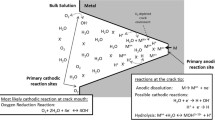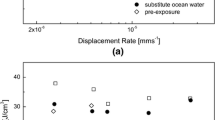Abstract
The Coupled Environment Fracture Model (CEFM) has been modified and calibrated to predict crack growth rate (CGR) in aluminum marine alloys. The customized CEFM provided quantitative predictions of the effects of O2, electrochemical potential, stress intensity factor, and conductivity on CGR in lightly sensitized AA5083-H321 in 3.5 wt.% NaCl solution, as well as explaining the development of a semi-elliptical surface cracks. The importance of the properties of the external environment, such as conductivity, oxidant/reductant concentration, and the kinetics of the cathodic reactions on the surfaces external to the crack has been confirmed. Crack growth is attributed to a sequence of microfracture events at the crack front, the frequency of which is determined by the mechanical conditions that exist at the crack tip, as governed by the stress intensity while the microfracture dimension is determined by hydrogen-induced fracture, with the CGR being the product of these two quantities. The success in explaining the intergranular stress corrosion cracking (IGSCC) of aluminum alloys, argues that the basic concept of the CEFM, that the internal and external environments are strongly coupled, is sound and that the CEFM, which was originally developed to describe IGSCC in sensitized stainless steels is equally applicable for describing IGSCC in lightly sensitized aluminum alloys.











Similar content being viewed by others
References
Searles JL, Gouma PI, Buchheit RG (2001) Stress corrosion cracking of sensitized AA5083 (Al–4.5Mg–1.0Mn). Metall Mater Trans A 32:2859–2867
Vassilaros MG (1994) In: Parkins RN (ed) Life prediction of corrodible structures. NACE International, Houston, pp 1656–1667
Jones RH, Baer DR, Danielson MJ, Vetrano JS (2001) Role of Mg in the stress corrosion cracking of an Al–Mg alloy. Metall Mater Trans A 32:1699–1711
Pickens JR, Gordon JR, Green JAS (1983) The effect of loading mode on the stress-corrosion cracking of aluminum alloy 5083. Metall Trans A 14A:925–930
Lea C, Molinari C (1984) Magnesium diffusion, surface segregation and oxidation in Al–Mg alloys. J Mater Sci 19:2336–2352
Vetrano JS, Williford RE, Buremmer SM, Jones RH (1997) Influence of microstructure and thermal history on the corrosion susceptibility of AA5083. In: Das SK (ed) Automotive alloys, vol. 77. TMS Annual Meeting, Orlando, FL, p 77
Sampath D, Moldenhauer S, Schipper HR, Mechsner K, Haszler A (2000) Decomposition of solid solution of the AA5083 alloy upon exposure to elevated temperatures. Mater Sci Forum 331–337:1089–1094
Windisch CFJ, Baer DR, Engelhard MH, Danielson MJ, Jones RH (2000) Corrosion of Mg- and Cu-implanted Al in 3.5 % NaCl solution. In: 198th Meeting of the Electrochemical Society
Baer DR, Windisch CF, Engelhard MH, Danielson MJ, Jones RH, Vetrano JS (2000) Influence of Mg on the corrosion of Al. J Vac Sci Technol A 18:131–136
Searles JL, Gouma PI, Buchheit RG (2002) Stress corrosion cracking of sensitized AA5083 (Al–4.5Mg–1.0Mn). Mater Sci Forum 396–402:1437–1442
Tanguy D, Bayle B, Dif R, Magnin T (2002) Hydrogen effects during IGSCC of pure Al–5Mg alloy in NaCl media. Corros Sci 44:1163–1175
Jones RH (2003) The influence of hydrogen on the stress-corrosion cracking of low-strength Al–Mg alloys. JOM 55:42–46
Jones RH, Vetrano JS, Windisch CF (2004) Stress corrosion cracking of Al–Mg and Mg–Al alloys. Corrosion 60:1144–1154
Davenport AJ, Yuan Y, Ambat R, Connolly BJ, Strangwood M, Afseth A, Scamans GM (2006) Intergranular corrosion and stress corrosion cracking of sensitised AA5182. Mater Sci Forum 519–521:641–646
Oguocha IN, Adigun OJ, Yannacopoulos S (2008) Effect of sensitization heat treatment on properties of Al–Mg alloy AA5083-H116. J Mater Sci 43:4208–4214
Gao J, Quesnel D (2011) Enhancement of the stress corrosion sensitivity of AA5083 by heat treatment. Metall Mater Trans A 42:356–364
Doig P, Jones GT (1977) A model for the initiation of hydrogen embrittlement cracking at notches in gaseous hydrogen environments. Metall Trans A 8:1993–1998
Ford FP, Silverman MJ (1980) The prediction of stress-corrosion cracking of sensitized 304 stainless-steel in 0.01M Na2SO4 At 97 °C. Corrosion 36:558–565
Ford FP, Andresen PL (1987) The theoretical prediction of the effect of system variables on the cracking of stainless steel and its use in design. Corrosion/87, San Francisco, CA
Ford F, Taylor D, Andresen P, Ballinger R (1987) Corrosion-assisted cracking of stainless and low-alloy steels in LWR environments. EPRI Report (Project 2006-6)
Li R, Ferreira MGS (1996) The thermodynamic conditions for hydrogen generation inside a stress corrosion crack. Corros Sci 38:317–327
Macdonald DD, Urquidi-Macdonald M (1991) A coupled environment model for stress corrosion cracking in sensitized type 304 stainless steel in LWR environments. Corros Sci 32:51–81
Macdonald DD, Lu P-C, Urquidi-Macdonald M, Yeh T-K (1996) Theoretical estimation of crack growth rates in type 304 stainless steel in boiling-water reactor coolant environments. Corrosion 52:768–785
Macdonald DD (1996) On the modeling of stress corrosion cracking in iron and nickel base alloys in high temperature aqueous environments. Corros Sci 38:1003–1010
Engelhardt G, Urquidi-Macdonald M, Macdonald DD (1997) A simplified method for estimating corrosion cavity growth rates. Corros Sci 39:419–441
Turnbull A (1997) Modelling of crack chemistry in sensitized stainless steel in boiling water reactor environments. Corros Sci 39:789–805
Boellinghaus T, Hoffmeister H (2000) Numerical model for hydrogen-assisted cracking. Corrosion 56:611–622
Chateau JP, Delafosse D, Magnin T (2002) Numerical simulations of hydrogen–dislocation interactions in FCC stainless steels: part I: hydrogen–dislocation interactions in bulk crystals. Acta Mater 50:1507–1522
Chateau JP, Delafosse D, Magnin T (2002) Numerical simulations of hydrogen–dislocation interactions in FCC stainless steels.: part II: hydrogen effects on crack tip plasticity at a stress corrosion crack. Acta Mater 50:1523–1538
Vankeerberghen M, Macdonald DD (2002) Predicting crack growth rate vs. temperature behaviour of type 304 stainless steel in dilute sulphuric acid solutions. Corros Sci 44:1425–1441
Manahan MP, Macdonald DD, Peterson AJ (1995) Determination of the fate of the current in the stress corrosion cracking of sensitized type 304SS in high temperature aqueous systems. Corros Sci 37:189–208
Macdonald DD, Scott AC, Wentrcek P (1981) Redox potential measurements in high temperature aqueous systems. J Electrochem Soc 128:250–257
Scully JC (1980) The interaction of strain-rate and repassivation rate in stress corrosion crack propagation. Corros Sci 20:997–1016
Gomez-Duran M, Macdonald DD (2003) Stress corrosion cracking of sensitized type 304 stainless steel in thiosulfate solution: I. Fate of the coupling current. Corros Sci 45:1455–1471
Gomez-duran M, Macdonald DD (2006) Stress corrosion cracking of sensitized type 304 stainless steel in thiosulphate solution. II. Dynamics of fracture. Corros Sci 48:1608–1622
Liu S, Macdonald DD (2002) Fracture of AISI 4340 steel in concentrated sodium hydroxide solution. Corrosion 58:835–845
Vijh AK (1968) Electrolytic hydrogen evolution reaction on aluminum in acidic solutions. J Phys Chem 72:1148–1156
Grosskreutz JC (1969) Mechanical properties of metal oxide films. J Electrochem Soc 116:1232–1237
Frost HJ, Ashby F (1982) Deformation-mechanism maps: the plasticity and creep of metals and ceramics. Pergamon, Oxford. pp. 20–29
Moon S, Pyun S (1998) Faradaic reactions and their effects on dissolution of the natural oxide film on pure aluminum during cathodic polarization in aqueous solutions. Corrosion 54:546–552
Chang JC, Chuang TH (2000) The degradation of corrosion resistance for Al 5083 alloy after thermal and superplastic forming processes. J Mater Eng Perform 9:253–260
Bard AJ, Faulkner LR (2000) Electrochemical methods: fundamentals and applications, 2nd edn. Wiley, New York
Hsiao IC, Huang JC (2002) Deformation mechanisms during low- and high-temperature superplasticity in 5083 Al–Mg alloy. Metall Mater Trans A 33:1373–1384
Liu Y, Cheng YF (2009) Cathodic reaction kinetics and its implication on flow-assisted corrosion of aluminum alloy in aqueous ethylene glycol solution. J Appl Electrochem 39:1267–1272
ASM Material Data Sheet. http://asm.matweb.com/search/SpecificMaterial.asp?bassnum=MA5083H116
ASTM G-67 (2004) Standard test method for determining the susceptibility to intergranular corrosion of 5xxx series aluminum alloys by mass loss after exposure to nitric acid (NAMLT test). Annual Book of ASTM Standards
Garcia HE, Gordon LI (1992) Oxygen solubility in seawater: better fitting equations. Limnol Oceanogr 37:1307–1312
Wilkinson DS, Vitek V (1982) The propagation of cracks by cavitation: a general theory. Acta Metall 30:1723–1732
Lu C, McDonald KT (1997) The effect of annealing on creep of aluminum wire. Princeton University, Princeton. pp. 1–14
Bencivenni G, Bucci L, Finocchiaro G, Forti C (1998) Creep measurement on aluminum-5056 wires. KLOE, Frascati, Italy. pp. 1–13
Kaufman JG (1999) Properties of aluminum alloys: tensile creep and fatigue data at high and low temperatures. ASM International, Materials Park, OH
Gao J (2011) Experiments to explore the mechanisms of stress corrosion cracking. Ph.D. thsis, University of Rochester
Holtz RL, Pao PS, Bayles RA, Longazel TM, Goswami R (2011) Corrosion-fatigue behavior of aluminum alloy 5083-H131 sensitized at 448 K (175 °C). Metall Mater Trans A 43:2839–2849
Crane CB, Gangloff RP (2011) Stress corrosion cracking of low temperature sensitized AA5083. In: Department of Defense 2011 Corrosion Conference. NACE, Houston. pp. 1–14
Lim MLC, Scully JR, Kelly RG (2013) Intergranular corrosion penetration in an Al–Mg alloy as a function of electrochemical and metallurgical conditions. Corrosion 69:35–47
Shoji T, Lu Z, Murakami H (2010) Formulating stress corrosion cracking growth rates by combination of crack tip mechanics and crack tip oxidation kinetics. Corros Sci 52:769–779
Acknowledgment
The authors greatly acknowledge the support of this work by AlphaSense, Inc. through STTR contract No. N00014-10-C-0438 from the Office of Naval Research.
Author information
Authors and Affiliations
Corresponding author
Rights and permissions
About this article
Cite this article
Lee, SK., Lv, P. & Macdonald, D.D. Customization of the CEFM for predicting stress corrosion cracking in lightly sensitized Al–Mg alloys in marine applications. J Solid State Electrochem 17, 2319–2332 (2013). https://doi.org/10.1007/s10008-013-2111-6
Received:
Revised:
Accepted:
Published:
Issue Date:
DOI: https://doi.org/10.1007/s10008-013-2111-6




